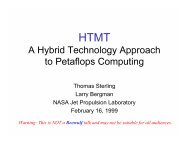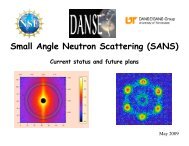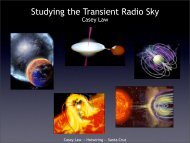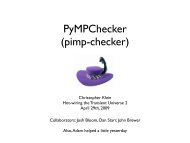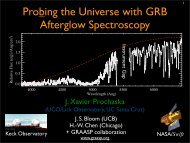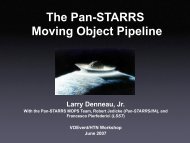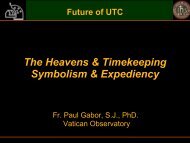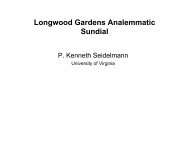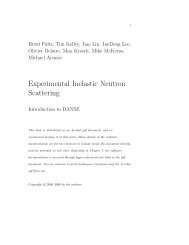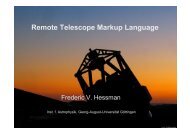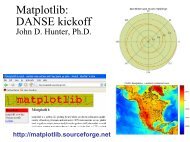Using UTC to Determine the Earth's Rotation Angle - Caltech Center ...
Using UTC to Determine the Earth's Rotation Angle - Caltech Center ...
Using UTC to Determine the Earth's Rotation Angle - Caltech Center ...
You also want an ePaper? Increase the reach of your titles
YUMPU automatically turns print PDFs into web optimized ePapers that Google loves.
Dennis D. McCarthy<br />
U. S. Naval Observa<strong>to</strong>ry
• Reference Systems<br />
– Origin<br />
– Specified axes<br />
– Conventional<br />
procedures and<br />
constants<br />
• Reference Frames<br />
– Realization<br />
– List of coordinates and<br />
motions<br />
• Angular<br />
• Cartesian
• Barycentric<br />
– z-axes related <strong>to</strong> rotational axis<br />
– x-axes in equa<strong>to</strong>rial plane directed <strong>to</strong>ward a fiducial point<br />
– third axes complete right-handed orthogonal system<br />
• Geocentric Celestial<br />
Reference System<br />
– geocentric space-time<br />
coordinates<br />
– kinematically non-rotating with<br />
respect <strong>to</strong> BCRS.<br />
• International Celestial<br />
Reference System<br />
– Idealized system<br />
– Kinematically non-rotating<br />
– Orientation<br />
• close <strong>to</strong> previous systems<br />
• independent of epoch,<br />
• International Celestial Reference Frame<br />
– set of extragalactic objects<br />
– Successive revisions minimize rotation from original orientation.<br />
– Angular coordinates of optical stars, consistent with that frame, are<br />
provided by <strong>the</strong> Hipparcos Catalogue
• Geocentric<br />
– z-axes fixed <strong>to</strong> Earth’s crust<br />
– x-axes in equa<strong>to</strong>rial plane directed <strong>to</strong>ward a fiducial point<br />
– third axes complete right-handed orthogonal system<br />
• Geocentric Terrestrial<br />
Reference System<br />
– co-rotating with Earth<br />
• International Terrestrial<br />
Reference System<br />
– aligned close <strong>to</strong> mean equa<strong>to</strong>r<br />
of 1900 and Greenwich<br />
meridian,<br />
– continuity with previous<br />
terrestrial systems.<br />
• independent of epoch,<br />
• International Terrestrial Reference Frame<br />
– instantaneous coordinates (and velocities) of reference points<br />
– aligned closely <strong>to</strong> previous terrestrial systems for continuity.
• Celestial<br />
– Geocentric<br />
– Related <strong>to</strong> GCRS by time-dependent rotation (precession-nutation)<br />
– Defined by equa<strong>to</strong>r of Celestial Intermediate Pole (CIP) and Celestial<br />
Intermediate Origin (CIO) on a specific date<br />
• Terrestrial<br />
– Geocentric<br />
– Related <strong>to</strong> ITRS by polar motion<br />
– Related <strong>to</strong> <strong>the</strong> Celestial Intermediate Reference System by Earth<br />
<strong>Rotation</strong> <strong>Angle</strong> (ERA) around <strong>the</strong> CIP<br />
– Defined by equa<strong>to</strong>r of Celestial Intermediate Pole (CIP) and Terrestrial<br />
Intermediate Origin (TIO)
Celestial Reference<br />
System<br />
REQUIRES<br />
1. Precession-<br />
Nutation Model<br />
2. Polar Motion<br />
(x, y)<br />
3. Earth tides<br />
model<br />
4. Earth <strong>Rotation</strong><br />
<strong>Angle</strong><br />
Terrestrial<br />
Reference System
• <strong>Angle</strong> measured along <strong>the</strong> intermediate<br />
equa<strong>to</strong>r of <strong>the</strong> Celestial Intermediate Pole<br />
(CIP) between <strong>the</strong> Terrestrial Intermediate<br />
Origin (TIO) and <strong>the</strong> Celestial<br />
Intermediate Origin (CIO).<br />
CIP<br />
• Related <strong>to</strong> UT1 by a conventionally<br />
adopted expression in which ERA is a<br />
linear function of UT1<br />
CIO<br />
• UT1 is <strong>the</strong> modern name for his<strong>to</strong>rical<br />
astronomical time scales, based on <strong>the</strong><br />
Earth’s rotation including Mean Solar<br />
Time, Greenwich Mean Time, Universal<br />
Time UT<br />
Earth<br />
<strong>Rotation</strong><br />
<strong>Angle</strong><br />
TIO<br />
• Variations in <strong>the</strong> rotational speed of <strong>the</strong> Earth and <strong>the</strong> consequent<br />
variations in <strong>the</strong> Earth’s rotation angle are conveniently represented by<br />
<strong>the</strong> quantity UT1-<strong>UTC</strong> (in time units).
1 second<br />
adjustments<br />
• From 1961 <strong>to</strong> 1972 <strong>UTC</strong><br />
contained both rate<br />
changes and steps <strong>to</strong><br />
maintain agreement<br />
with UT2 within about<br />
0.1 s<br />
• After 1972 only onesecond<br />
steps<br />
TAI<br />
<strong>UTC</strong>
• Dominant motions<br />
– Trend<br />
– Decadal<br />
– Annual/semiannual<br />
– Tidal<br />
• O<strong>the</strong>r smaller amplitude<br />
motions<br />
• Causes of UT1-<strong>UTC</strong><br />
– Tidal deceleration<br />
– Internal changes in<br />
inertia tensor<br />
– Atmosphere (winds)<br />
– Solid Earth tides
Reference pole motion<br />
in space (model)<br />
<strong>Rotation</strong> angle<br />
(observed/predicted)<br />
[CRS]=PN(t) R(t) W(t) [TRS]<br />
Reference pole motion<br />
on Earth (observed/<br />
predicted)<br />
Space “Coordinate”<br />
Earth “Coordinate”
Equation <strong>Using</strong> Greenwich of equinoxes Sidereal = Δψ cos Time ε A<br />
(Legacy)<br />
IAU Recommended<br />
Equation of equinoxes = Δψ cos ε A<br />
Tidal Corrections<br />
Tidal Corrections<br />
Software at http://maia.usno.navy.mil/ch5subs.html<br />
ERA2000 subroutine produces <strong>the</strong> Earth rotation angle θ
• GST = ERA(UT1) – EO<br />
• EO = -0.01450600″ - 4612.15653400″t - 1.391581700″t 2<br />
+ 0.0000004400”t 3 - Δψ cosε A – P<br />
• t = (Terrestrial Time (TT) - 2451545.0TT)/36525 and Δψ cosε A is <strong>the</strong><br />
classical equation of <strong>the</strong> equinoxes<br />
• P represents a series of periodic terms given in Table 5.2e of <strong>the</strong><br />
IERS Conventions (2010).
ERA(T U<br />
) = θ(T U<br />
)<br />
= 2π (0.779 057 273 264 0<br />
+ 1.002 737 811 911 354 48T U<br />
)<br />
T u<br />
= (Julian UT1 date - 2451545.0),<br />
Software at http://maia.usno.navy.mil/ch5subs.html<br />
ERA2000 subroutine produces <strong>the</strong> Earth rotation angle θ
• Both methods require UT1<br />
• Computed from<br />
UT1 = <strong>UTC</strong> + (UT1-<strong>UTC</strong>)
= International A<strong>to</strong>mic Time<br />
(TAI) + 32.184s<br />
= <strong>UTC</strong><br />
+ [(TAI – <strong>UTC</strong>) + 32.184s]
• <strong>UTC</strong><br />
– Leap seconds imply<br />
UT1 = <strong>UTC</strong><br />
– Error < 0.9s<br />
• IERS Observed<br />
– UT1-<strong>UTC</strong> with error <<br />
10 µs<br />
• IERS Predicted<br />
– Based on<br />
• Observations<br />
• Models<br />
– Sort term<br />
– Long term<br />
• GPS III<br />
Diurnal and semi-diurnal tidal corrections <strong>to</strong> UT1 are available
• Established as International Earth <strong>Rotation</strong> Service in 1987 by<br />
International Astronomical Union and International Union of<br />
Geodesy and Geophysics<br />
• In 2003 renamed <strong>to</strong> International Earth <strong>Rotation</strong> and Reference<br />
Systems Service.<br />
• Serves astronomical, geodetic and geophysical communities by<br />
providing:<br />
– International Celestial Reference System (ICRS) and its realization,<br />
<strong>the</strong> International Celestial Reference Frame (ICRF).<br />
– International Terrestrial Reference System (ITRS) and its realization,<br />
<strong>the</strong> International Terrestrial Reference Frame (ITRF).<br />
– Earth orientation parameters required <strong>to</strong> transform between <strong>the</strong> ICRF<br />
and <strong>the</strong> ITRF and for research.<br />
– Geophysical data <strong>to</strong> interpret time/space variations in <strong>the</strong> ICRF, ITRF<br />
or earth orientation parameters, and model such variations.<br />
– Standards, constants and models (i.e., conventions) encouraging<br />
international adherence.
Positioning<br />
and<br />
Navigation<br />
Pointing<br />
Timekeeping<br />
Research
1970<br />
• UT1 required for celestial<br />
navigation<br />
• UT1 observation<br />
accuracy ~1 ms<br />
• No predictions of UT1<br />
available<br />
• Printed bulletins only<br />
source<br />
2011<br />
• Diminished use of<br />
celestial Navigation<br />
• UT1 observation accuracy<br />
~10 µs<br />
• Near real time UT1 and<br />
predictions available<br />
• Near real time electronic<br />
access
Legacy<br />
R(t) computed from<br />
Greenwich Sidereal Time<br />
IAU Recommended<br />
R(t) computed from<br />
Earth <strong>Rotation</strong> <strong>Angle</strong><br />
Ei<strong>the</strong>r method requires a value for UT1 by computing<br />
UT1=<strong>UTC</strong> + (UT1-<strong>UTC</strong>)<br />
UT1-<strong>UTC</strong> available from IERS/USNO<br />
• Full Accuracy<br />
• Fundamental solution<br />
OR<br />
Ignore UT1-<strong>UTC</strong><br />
• Errors as large as 13.5 sec. of arc.<br />
Software at http://maia.usno.navy.mil/ch5subs.html<br />
ERA2000 subroutine produces <strong>the</strong> Earth rotation angle θ



